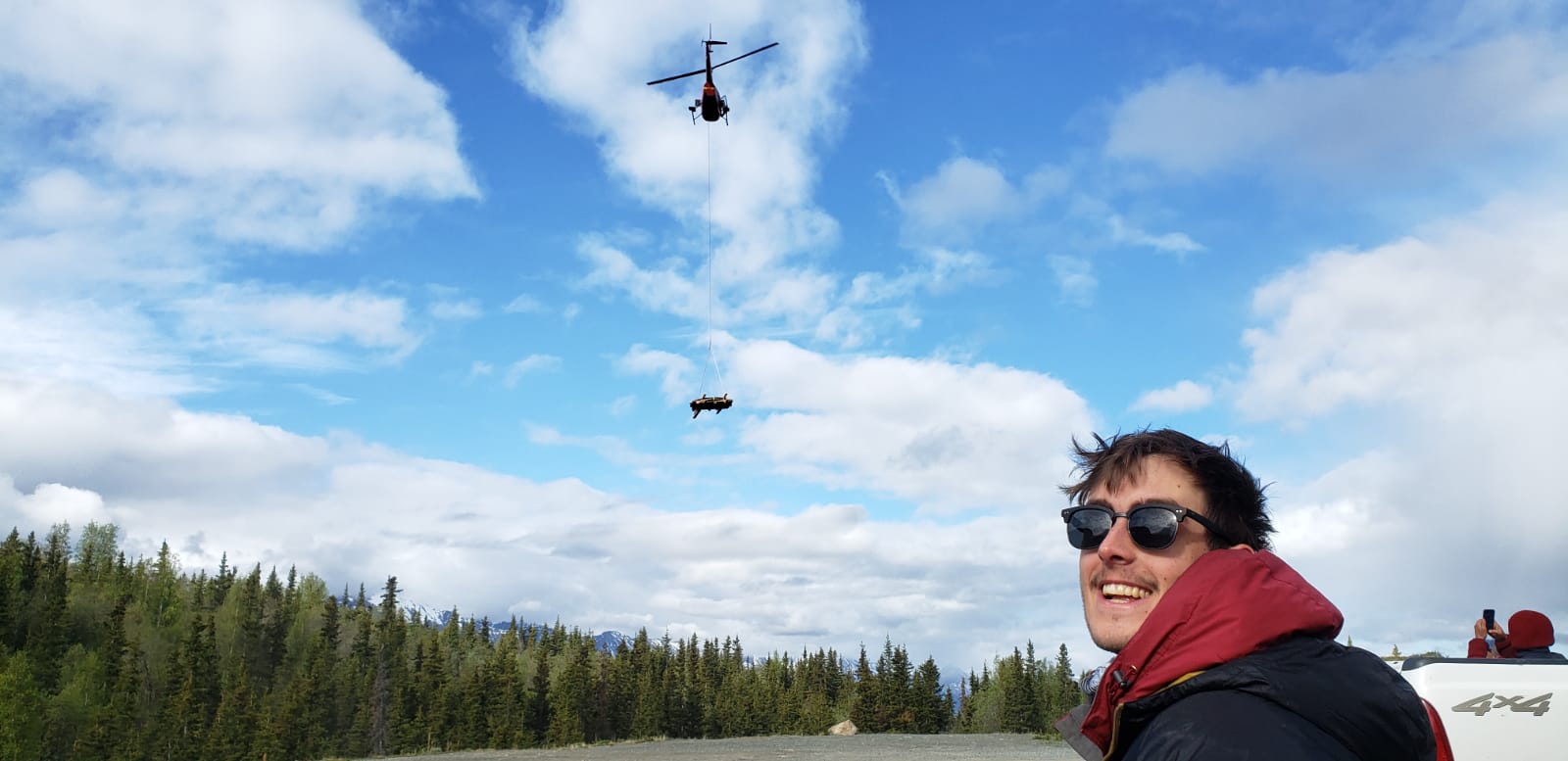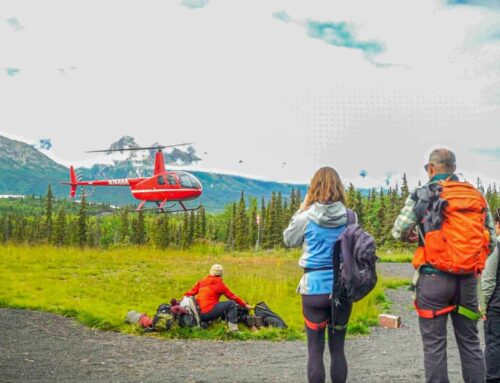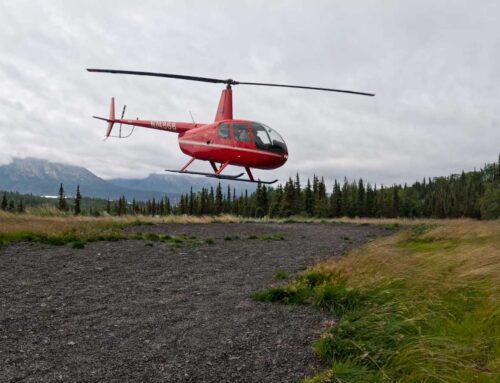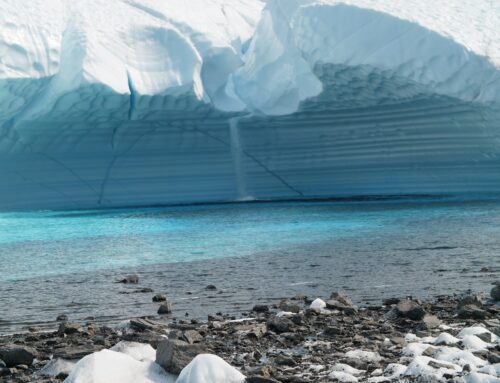To Build a Glacier Camping Adventure Site
When you arrive at the MICA Guides base, near Glacier View, a leveled driveway and sign greet you. Once in the parking lot, you’ll find yourself surrounded with amenities; A washhouse, espresso and ice cream stand, gear huts, a yurt to check-in, and more. As you look around, it is best to keep in mind that all of these buildings and creations were all designed and handcrafted by the MICA Guides crew. Not all at once, but over time, the accumulation of past and present seasons. This season brought the glacier camping adventure site build.
Over the years, as the team grows, a new project is put on the plate, and the guides on staff step up to lend a hand each season. This year was no exception, even after a worldwide pandemic.
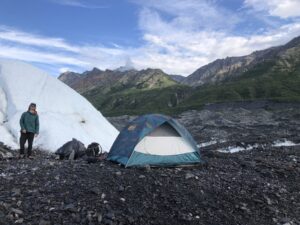
In the early stages of the Glacier Overnight, guides set up test sites and runs for the experience.
A Pandemic and a Plan
To say the season of 2020 was tumultuous would be an understatement. As COVID ravaged the travel industry, numbers were still steady (thanks to the locals who came out to enjoy their backyard). Simultaneously, there was more time to design and execute a new summer project. The year of 2020 was the year that many guides got to see a popularly shared dream become a reality; MICA Guides created the chance for guests to spend a night on the glacier, and in luxury.
Julian Winston, a second year guide and senior glacier guide, got to experience this project build first hand. Julian is from upstate New York, with a heart for exploration and creation. He joined the company in 2020 despite the obstacles that lay ahead to be an assistant guide intern. He was fully aware that the season was going to be unlike any other.
An Overnight Crew
In 2020 Julian was tasked with being apart of a sub-committee created to organize and plan the overnight glacier experience. There were a hand full of interns and senior guides involved in this group. Being added to this crew suits Julian well with his ability to roll with the punches and excitement for a good challenge.
He describes the experience starting out with only some trips using helicopter access. Others took the long and grueling trek over the glacier moraine to get to the back country for this remote ice experience.
A Genesis
Julian animatedly tells about each guide, 3-4 of them, carrying anywhere from 80 to 100 lbs. of gear. All this gear made it way out to the backcountry of the glacier to be set up and later, broken down again. In addition to the grueling weight came miles of moraine bashing to and from base camp in Glacier View.
Along with the literal weight that came with the set up, there was also the metaphorical weights. Weaving between the macro and the micro details to create a whole picture of the experience. The guides learned from the exposure and smoothed out any small hiccups that came up, even after extensive planning. He said it was worth it all to see the experience come to life.
The Dream Continues
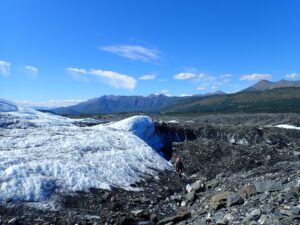
The lateral moraine of the Matanuska Glacier is rocky and often grueling to travel miles over.
Fast forward to this year. With a full team, many came out to take on the challenges of glacier life after lockdown. The sub-committee is back in full swing, facing new challenges.
This years starting goal was to set up an 18 ft. semi-permanent platform in the backcountry that was both movable and solid structure. But there would be no hauling materials out by pack, it would be by sling load with a helicopter.
During the hustle and bustle of week zero is when Don Wray, company owner and operator, approached Julian to let him know he would be hands-on with this season’s addition to the overnight glacier experience; setting and helping to organize the sling loads of building materials to be flown out by helicopter.
Get Organized
Luckily Julian wasn’t going to be doing this alone. Many hands and minds put hours of preplanning into the helicopter transportation of materials for the glacier camping adventure site. From weight, to break down and rebuild, to factoring in the unknown. They had a game plan.
That night Julian and the team organized and adjusted materials into two separate loads for the helicopter to sling load in the morning. They factored in how the materials would need to be unloaded on the glacier, resulting in constant attention to very small details. Weight distribution and fastening seemed to be priority factors in a successful transport. That meant weighing each pre-cut piece individually and setting up mock loads in the company parking lot before hand to practice.
The Challenges of Creating
When asked what challenges Julian and the team saw coming in this project he responds with those of the known and unknown; building material costs, time constraints, technicalities of operations, and of course the quick turn of Alaska weather.
The next morning everyone was up and at the ready in the parking lot. Fastening, strapping, and triple checking their calculations. They slowly made their way to the launch pad by vehicle with both sling loads in tow. In addition to the feat of an oversized and extremely heavy load, the wind speed had picked up considerably overnight. This made the short journey down the road quite exciting for everyone. Finally, Julian and the crew reached the launch pad. They all then dismantled the materials and repacked the sling loads to be lifted, for the umpteenth time.
That is when they got the call from the pilot. He confirmed what they all had been thinking. The launch for the day would be a no go due to the high gusts of wind. With this heavy news the team quickly worked to adapt their focus to the issue at hand; What were they going to do with all these materials until the next chance to fly?
Rolling with the Punches
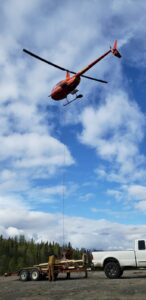
A pilot lifts off with a secure load of building materials, ready for the backcountry of the Matanuska Glacier.
After some discussion and a bit of luck finding a trailer, the team decided to disassemble and repack the load onto a 16 ft. trailer for the night. With fingers crossed they left the materials on the side of the road to hopefully be flown the next day. Everyone set off back to base to wait.
That night was the party for the arrival of all the new interns. Julian rolled with the hustle and bustle of these transitions. Enjoying the party while simultaneously pressed with thoughts of what was next for this project. Soon, Don Wray (owner and operator) would let him know that he would be on deck to see the project out bright and early in the morning.
Second Time is the Charm
As the sun rose the next day, the wind was gentle, and ready for an air transport to build the glacier camping adventure site. The team sprang to action, not willing to give time for the weather to change it’s mind as it does. To their relief the materials where still at the ready. The sling loads had to be rebound again and each and every bit weighed one last time.
Julian recounts how seamless the set up was that morning. Once the two loads were ready Julian was approached to be one of the team members to clip the load in. As he did, and the line tightened, relief flooded everyone as the sling load started to lift and finally, head out to the glacier.
It took less than 12 hours for this band of guides and experts to hit a hurdle, and then overcome it. This achievement wasn’t just marked by those past two days though. This was a culmination of years of building a new layers of resiliency. Of accomplishing things many had only dreamed of, despite the endless trials.

